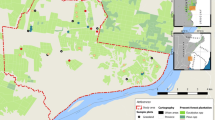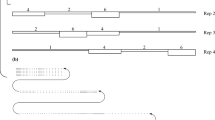Abstract
This paper discusses a plantation management approach involving a combination of “short” and “long” rotations designed to allow farmers to receive income from trees as soon as possible after establishment. We present results from two plots that represent extreme conditions: (a) a seasonally waterlogged, non-saline site (Nahalal), and (b) a saline site (Ginnegar) located in the Yizre’el Valley, Israel. Six improved seed sources, four of Eucalyptus camaldulensis and two of E. occidentalis, were examined. The local Israeli seed source of E. camaldulensis (HA) performed best at both sites. In Nahalal, the short rotation thinning of the slower growing (50%) plantation trees could provide economic returns approximately five years after establishment. The calculated mean annual increment (MAI) of these trees reached 12.2 t ha−1 year−1. The long rotation, or better performing half of the plantation trees, could be used as a source of sawn timber, providing higher-value products. By nine years after establishment, the average DBH of the various seed sources reached 25.8 ± 1.9 cm. The calculated MAI of the combined cutting rotations reached 48.3 t ha−1 year−1. Eucalyptus grown under the combined (short- and long-term) management approach at Nahalal was more profitable than many other non-irrigated local crops. Eucalyptus production in Ginnegar would be less profitable than in Nahalal. However, an additional ecological benefit was provided by the crop’s ability to lower the water table. When this contribution to regional drainage is taken into account, trees become economically competitive with other non-irrigated field crops under saline conditions.




Similar content being viewed by others
References
Aguiar IB, Valeri SV, Spinelli P, Sartori Filho A, Pires CA (1995) Thinning effect on height and diameter growth of Eucalyptus citriodora. IPEF, Instituto de Pesquisas e Estudos Florestais 48/49:1–7
Amatayakul W, Azar C (2003) Eucalyptus plantations for electricity generation: the cost of carbon dioxide abatement in Thailand. Int J Sustain Dev. Inderscience Enterprises Ltd, Geneva, Switzerland 6(3):359–377
Anonymous (1979) Eucalyptus or planting. FAO Forestry Series no. 11. FAO, Rome. pp 677
Arnold RJ, Bacca MJ, Clark N (1999) Commercial irrigated E. camaldulensis plantations—a Californian experience and its applicability in Australia. Aust For 62(2):154–159
Aslam Z, Awan AR, Qureshi MAA, Mahmood T, Haq MI, Chaudhry AK, Malik KA (2002) Growth, ion uptake, agro-industrial uses and environmental implications of Eucalyptus camaldulensis in saline systems. Prospect Saline Agric 37:277–285
Bacon PE, Stone C, Binns DL, Leslie DJ, Edwards DW (1993) Relationships between water availability and Eucalyptus camaldulensis growth in riparian forest. J Hydrol 150:541–561
Banham PW, Orme K, Russel SL (1995) Pulpwood qualities required for the cold soda pulping process. In: Potts BM, Borralho NMG, Reid JB, Cromer NR, Tibbits WN, Raymond CA (eds) Eucalypt plantations: improving fibre yield and quality. CRCTHF-IUFRO conference, 19–24 February. Hobart, Australia, pp 1–4
Bell DT (1999) Australian trees for the rehabilitation of waterlogged and salinity-damaged landscapes. Aust J Bot 47:697–716
Benyon RG, Marcar NE, Crawford DF, Nicholson AT (1999) Growth and water use of Eucalyptus camaldulensis and E. occidentalis on a saline discharge site near Wellington, NSW, Australia. Agric Water Manag 39:229–244
Bernardo AL, Reis MGF, Reis GG, Harrison RB, Firme DJ (1998) Effect of spacing on growth and biomass distribution in Eucalyptus camaldulensis, E. pellita and E. urophylla plantations in southeastern Brazil. For Ecol Manag 104:1–13
Crabtree JR, Pinard MA, Elliott GK, Moffat A, Arnold B (2000) A book review of Steward-Roper C, Parks A (eds) The living forest: non-market benefits of forestry. Forestry 73:209–214
Cramer VA, Thorburn PJ, Fraser GW (1999) Transpiration and groundwater uptake from farm forest plots of Casuarina glauca and Eucalyptus camaldulensis in saline areas of southeast Queensland, Australia. Agri Water Manag 39:187–204
Fleischer A, Tsur Y (1999) Measuring the recreational value of agricultural landscape, working paper no. 9911. The Center for Agricultural Economic Research, Rehovot, Israel
Forrester DI, Baker TG (2007) Growth response to thinning in a productive Eucalyptus globulus plantation in Victoria. In: Proceedings of the international conference on plantation eucalyptus: challenge in product development. November 28–December 1, 2005, Zhanjiang, Guangdong, China, CRIWI, pp 30–37
Gafni A (1994) Biological drainage – a rehabilitation option for salinity-damaged lands. Water Irrig 337:33–36 (in Hebrew)
Gafni A, Zohar Y (2001) Sodicity, conventional drainage and bio-drainage in Israel. Aust J Soil Res 39:1269–1278
Gafni A, Zohar Y (2007) Hydrological and salinity impacts of a bio-drainage strategy application in the Yizre’el Valley, Israel. Hydrol Process 21(16):2164–2173
Gafni A, Biniamini Y, Marish S, Gotesman M (1991) Hydrological factors of the salinization of soils and water resources in the Yizre’el Valley, Israel. Research report no. 61–90, Soil Erosion Research Station, Ministry of Agriculture (in Hebrew)
Hadas E (2001) An economic analysis of various options for commercial forestry. Internal report to the Ministry of Agriculture, Bet Dagan, Israel (in Hebrew)
Hamaza KFS (1999) Basic density and some anatomical properties of Eucalyptus camaldulensis Dehn, E. citriodora Hook, and E. paniculata Sm. grown at Ruvu, Tanzania. Ann For 7(2):221–226
Hatton T, Reece P, Taylor P, McEwan K (1998) Does leaf water efficiency vary among eucalypts in water-limited environments? Tree Physiol 18:529–536
Heuperman AF, Kapoor AS, Denecke HW (2002) Biodrainage—principles, experiences and applications. International Programme for Technology and Research in Irrigation and Drainage, FAO Knowledge Synthesis Report no. 6
Hooda N, Gera M, Andrasko K, Sathaye J, Gupta MK, Vasistha HB, Chandran M, Rassaily SS (2007) Community and farm forestry climate mitigation projects: case studies from Uttaranchal, India. Mitig Adapt Strat Glob Change 12:1099–1130
Hussain RW, Cheema MA (1987) Possibility of application of thinning grades in terms of basal area in E. camaldulensis plantations. Pakistan J For 37(1):21–25
Israeli Meteorological Service (IMS) (1990) Standard climatological averages of the rainfall amounts 1961–1990. Israel Meteorological Service, Ministry of Transport, Bet Dagan (in Hebrew)
Kapoor AS (2001) Biodrainage – a biological option for controlling waterlogging and salinity. Tata McGraw-Hill, New Delhi, p 315
Karschon R (1974) The relation of seed origin to growth of Eucalyptus camaldulensis Dehn. in Israel. Isr J Agric Res 23:159–173
Lambert M, Turner J (2000) Commercial forest plantations on saline lands. CSIRO Publishing, Monsanto, Xylonova, Land & Water Conservation, Australia, pp 91–93, 145
Langholtz M, Carter DR, Rockwood DL, Janaki RR, Alavalapati JRR (2007) The economic feasibility of reclaiming phosphate-mined lands with short-rotation woody crops in Florida. J For Econ 12(4):237–249
LeBlanc JW, Hasey JK, Standiford RB, Connor M, Sachs RM (1997). Eucalyptus for low elevation foothill plantations in California. West J Appl For 12(4):104–107
Lorenzo AB, Blanche CA, Qi Y, Guidry MM (2000) Assessing residents’ WTP to preserve the community urban forest: a small-city case study. J Aboric 26(6):319–337
Luttik J (2000) The value of trees, water and open space as reflected by house prices in the Netherlands. Landsc Urban Plan 48:161–167
Mahmood K, Morris J, Collopy J, Slavich P (2001) Groundwater uptake and sustainability of farm plantations on saline sites in Punjab province Pakistan. Agric Water Manag 48:1–20
Marcar N (2002) Farm forestry options for saline environments. Prospect Saline Agric 37: 261–268
Meddings RLA, McComb JA, Bell DT (2001) The salt-waterlogging tolerance of Eucalyptus camaldulensis E. globulus hybrids. Aust J Expt Agric 41:787–792
Miranda I, Almeida MH, Pereira H (2001) Influence of provenance, subspecies and site on wood density in Eucalyptus globulus Labill. Wood Fiber Sci 33(1):9–15
Misgav A (2000) Visual preference of the public for vegetation groups in Israel. Landsc Urban Plan 48:143–159
Morris J, Mann L, Collopy J (1998) Transpiration and canopy conductance in a eucalypt plantation using shallow saline groundwater. Tree Physiol 18:547–555
Moura VPG, Barnes RD, Birk JS (1987) A comparison of assessing wood density in provenances of Eucalyptus camaldulensis Dehn. and other Eucalyptus species in Brazil. Aust For Res 17:83–90
Sahunalu P, Puriyakorn B, Dhanmanonda P, Hiranpan P (1990) Production of small size fuelwood from the thinning of Eucalyptus camaldulensis Dehnh. plantation. Kasetsart J, Nat Sci 24(3):306–319
Schein Z, Livne A (1998) Drainage for salinity control in the Jezreel Valley in Israel. In: Drainage in the 21st century: food production and the environment. Proceedings of the 7th annual drainage symposium, Orlando, Florida
Sesbou A, Nepveu G (1978) Intraspecific variability of shrinkage with collapse and of wood density in Eucalyptus camaldulensis. Ann Sci For 35(4): 237–263 (in French)
Shedley P, Bentley K (2007) Opportunities for adding value to plantation grown Eucalyptus logs. In: Proceedings of the international conference on plantation eucalyptus: challenge in product development. November 28–December 1, 2005, Zhanjiang, Guangdong, China, CRIWI, pp 1–9
Sun D, Dickinson GR (1995) Survival and growth responses of a number of Australian tree species planted on a saline site in tropical north Australia. J Appl Ecol 32:817–826
Volker PW, Greave B, Wood M (2007) Silvicultural management of eucalypt plantations for solid wood and engineered wood products-Experience from Tasmania. In: Proceedings of the international conference on plantation eucalyptus: challenge in product development. November 28–December 1, 2005, Zhanjiang, Guangdong, China, CRIWI, pp 1–9
Yan P, Minsheng Y (2007) Eucalypt and acacia species for production of solid wood products in China. In: Proceedings of the international conference on plantation eucalyptus: challenge in product development. Zhanjiang, Guangdong, China, November 28–December 1, 2005, CRIWI, pp 79–91
Zohar Y (1989) Biomass production of short rotation Eucalyptus camaldulensis Dehn. stands growing on peat soil under a high water table in Israel. S Afr For J 149:54–57
Zohar Y (1993) The green revolution of eucalypts. A.R.O., The Volcani Center, Bet Dagan, Israel, pp. 81 (in Hebrew)
Zohar Y, Gafni A (1994) Economic use of eucalyptus plantations as biological drainage in rehabilitation of marginal agricultural lands. Hassadeh 74:1219–1220 (in Hebrew)
Zohar Y, Karschon R (1984) Above-ground biomass of Eucalyptus camaldulensis Dehn. in Israel. S Afr For J 128:26–29
Zohar Y, Moreshet S (1987) Provenances of Eucalyptus occidentalis in the arid zone of Israel. For Ecol Manag 22:71–77
Zohar Y, Schiller G (1998) Growth and water use by selected seed sources of eucalyptus under high water table and saline conditions. Agric Ecosyst Environ 69:265–277
Acknowledgements
The authors would like to express their thanks to the JNF-LDA for generously funding this research and providing considerable assistance with the field work. Especially appreciated Dr. Omri Bonea, Meir Kofman, Shally Ben-Ishay and Baruch Gabay for their logistic assistance. The authors gratefully acknowledge the meticulous monitoring performed by Yosi Moshe from the Agricultural Research Organization. Dr. Avram Gnizi (of blessed memory) and Miri Zarhi is commended for their help in analyzing the data and for providing valuable advice on statistical procedures. Finally, the authors would like to thank the “Mei Hasharon” company for volunteering to carry out the periodical thinning operations in the field plots and test the quality of the cut woods. Alfred Heuperman of Tatura, Australia provided editing services and valuable comments for the final draft of this document.
Author information
Authors and Affiliations
Corresponding author
Additional information
Jim Morris–Deceased.
Rights and permissions
About this article
Cite this article
Zohar, Y., Gafni, A., Morris, J. et al. Eucalyptus plantations in Israel: an assessment of economic and environmental viability. New Forests 36, 135–157 (2008). https://doi.org/10.1007/s11056-008-9089-4
Received:
Accepted:
Published:
Issue Date:
DOI: https://doi.org/10.1007/s11056-008-9089-4




